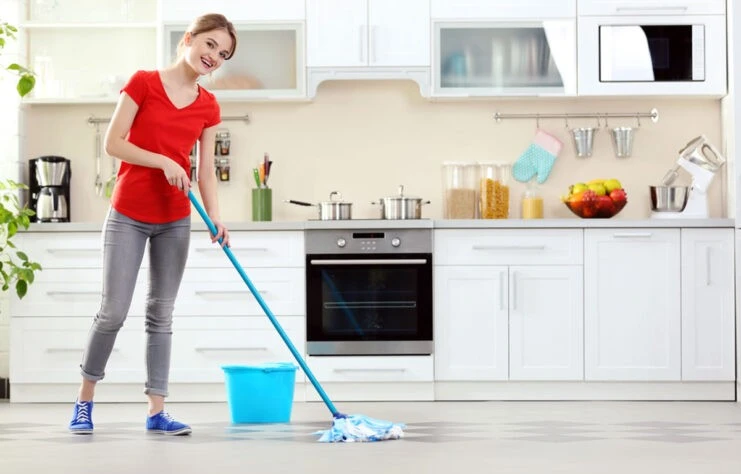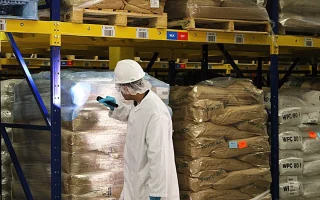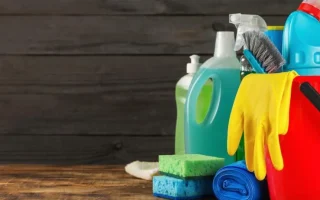You know the saying – the kitchen is the heart of the home, a place where meals are prepared, shared, and enjoyed with loved ones. Keeping it that way is essential, and deep cleaning on a regular basis helps remove grease, grime, and food residues from surfaces, appliances, and hidden corners.
In this comprehensive guide, residential cleaning experts from St. Louis will walk us through the step-by-step process of deep cleaning your kitchen from top to bottom. Want to ensure a safe and sanitary space for cooking and dining? Read on!
What does kitchen deep cleaning entail?
Deep cleaning your culinary space is a vital task that helps maintain a clean, hygienic, and welcoming space for cooking and dining. By incorporating regular deep cleaning into your household routine, you’ll keep your space looking its best. Here’s what to do:
Gather Your Cleaning Supplies
Before you begin, gather all the necessary supplies and equipment to streamline the process. This may include microfiber cloths, sponges, scrub brushes, all-purpose cleaner, degreaser, baking soda, white vinegar, dish soap, and rubber gloves. Having everything you need on hand will help you tackle each task efficiently and effectively.
Declutter and Organise
Start by decluttering and organizing your kitchen to create a clutter-free workspace. Remove items from countertops, cabinets, and drawers, and sort through them to determine what to keep, donate, or discard. Wipe down surfaces and shelves as you go to remove dust and debris, and reorganize items in a logical and functional manner for easy access and storage.
Clean and Disinfect Countertops
Next, focus on disinfecting your countertops to remove food residues, spills, and bacteria. Use a mild detergent or all-purpose cleaner to wipe down countertops, paying special attention to high-touch areas such as around the sink and stove. For stubborn stains or stuck-on grime, create a paste with baking soda and water and gently scrub the affected areas with a sponge or scrub brush. Finish by disinfecting countertops with a solution of bleach or a commercial disinfectant spray to kill germs and bacteria.
Deep Clean Your Appliances
Taking care of appliances is an essential part of kitchen maintenance to ensure they operate efficiently and hygienically. Start with the interior and exterior of your refrigerator, removing shelves and drawers for thorough cleaning. Defrost the freezer if necessary and wipe down all surfaces with a solution of water and vinegar to remove odors and stains. For the oven and stovetop, use a degreaser or oven cleaner to remove baked-on grease and food residues, and scrub grates and burner caps with a brush or scouring pad. Don’t forget about the microwave, dishwasher, and other small appliances as well.
Refresh Cabinets and Drawers
Over time, cabinets and drawers can accumulate dust, grease, and food crumbs, making them prime breeding grounds for pests and bacteria. Turn your attention to your cabinets and drawers, removing contents and wiping down surfaces with a damp cloth or sponge. Use a mild detergent or vinegar solution to remove grease and grime, and pay attention to corners, handles, and hinges where dirt tends to accumulate. For sticky residues, apply a paste of baking soda and water and gently scrub with a soft brush.
Scrub Sink and Fixtures
The kitchen sink and fixtures are often overlooked but can harbor bacteria and germs if not properly cleaned and maintained. Scrub the sink basin, faucet, and drain with a mixture of baking soda and water to remove stains and mineral deposits. Use a toothbrush or small brush to clean around the faucet and handles, and rinse thoroughly with water. For stainless steel sinks, polish with a cloth and stainless steel cleaner to restore shine and remove water spots.
Clean Floors and Baseboards
Finally, tackle the floors and baseboards to complete your routine. Sweep or vacuum the floors to remove dirt and debris, paying attention to corners and under appliances. Mop the floors with a solution of water and floor cleaner, focusing on high-traffic areas and spills. Use a damp cloth or sponge to wipe down baseboards, remove dust and dirt, and touch up with paint or wood polish if needed to restore their appearance.







